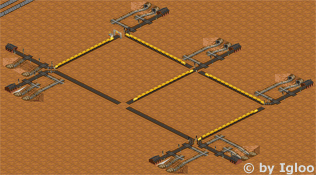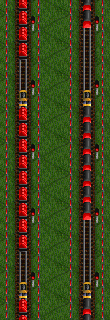The insane LED Counter & Logic Gates [Part 1]
While browsing tt-forums I stumbled upon a LED Counter created in an OpenTTD game. This is an amazing work because you require a basic knowledge about electronics as well as about OpenTTD and signaling. This work inspired me and I planned to do some other constructions.

Of course this counter is a complex electronic circuit and we should not look at it in a too close manner. It uses half-adders, memory and a lot of logic gates. But some parts, especially the logic gates, are really interesting.
My first intention was to optimize them to be useful in #openttdcoop network games.
Logic Gates – An Overview
Boolean Operators a.k.a. Signals
First of all, we’ll have a look at the requirements to understand logic gates, as I create them, in OpenTTD. A default signal can be either red or green. These two states can be defined as true and false or as 1 and 0 or zero and non-zero or easily as yes and no. In fact, Read the rest of this entry »
 Whenever starting a new game, be it local or on #openttdcoop, one important question to be cleared before starting to build the network always is: “What tilelength (TL) are we going to use for our trains?”.
Whenever starting a new game, be it local or on #openttdcoop, one important question to be cleared before starting to build the network always is: “What tilelength (TL) are we going to use for our trains?”.